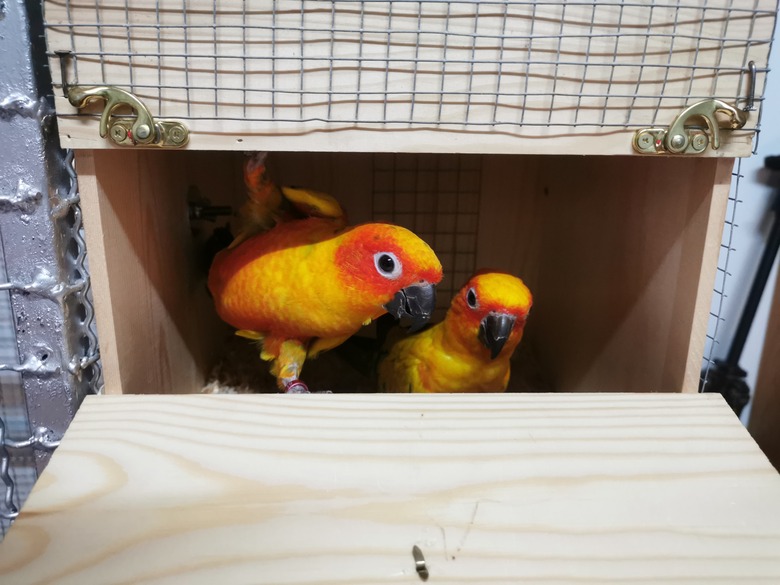How To Make A Sun Conure Nest Box
We may receive a commission on purchases made from links.
Sun conures are medium parrots who grow to about a foot tall. The birds will start showing breeding behavior at about 18 months old but won't be capable of producing viable offspring until around 2 years old. Provide a conure breeding box if you have male and female birds who are compatible with each other and you might end up with more birds.
Is a nest box necessary?
Is a nest box necessary?
If you have only a female bird, no nest box is needed. Both a male and female sun conure are needed to produce fertilized eggs that will hatch young birds. Females will lay eggs from time to time even without a male around. Although you can choose to remove the unfertilized eggs and dispose of them, this can stimulate some females to lay even more eggs.
By not providing a nest box, it's less likely she'll be stimulated to lay eggs. Reducing sunlight and how you much you handle a female bird can also reduce her natural urge to nest. However, if you have a male and female whom you hope to breed, installing a nest box is essential.
Sun conure nesting box requirements
Sun conure nesting box requirements
Sun conures aren't choosy about where they make a nest when they're ready to breed. Some might even use the corner of the cage if a nest box isn't available. However, creating a cozy and protected environment with certain essentials will prevent accidental injury to the young from getting trampled or injured by the cage.
Sun conure nest boxes can be either horizontal or vertical but should be spacious enough for both birds to stand upright and move around without having to step on their eggs. An untreated plywood box is ideal for the structure, as it will help hold in warmth and replicate the hollow logs they use to nest in when out in the wild.
Cut a round hole large enough for your conures to pass through as they enter and exit the nest box. A perch on the outside and a welded mesh ladder for them to climb out of the nest box on the inside will prevent them from having to jump in or out — a move that could injure baby birds or crush an egg.
Keeping it clean
Keeping it clean
The conure nesting box should have either a removable lid or a hinged opening where you will be able to access the nest area to change out soiled bedding and check on your birds. Make sure the hinged opening or lid can be secured by latches or other means to prevent your birds from escaping. Angle the floor slightly toward the back of the nest box to keep the eggs from rolling around. Provide ample, clean pine shavings that are dust-free for the mom bird to create a nesting surface.
If you are using a wire mesh breeding cage, attach your nest box to the outside of the cage using metal hooks that screw into the plywood. Clip a hole using wire clippers so your birds can access the nest box through the front hole and attach a perch. Secure the cage with wire to hold it in place.
Equipment to support nesting conures
Equipment to support nesting conures
A nest box provides a sun conure pair a safe, supportive environment for raising young. However, there is additional equipment you'll want to have ready in the event the pair cannot or will not finish the job themselves.
A parrot egg incubator is recommended, especially if your parent birds are young and inexperienced. If the female abandons the nest, you can incubate the eggs yourself for the rest of the time. A brooder where the chick can live for the first few weeks of life is also necessary to provide heat and humidity until he can regulate his own body temperature.
